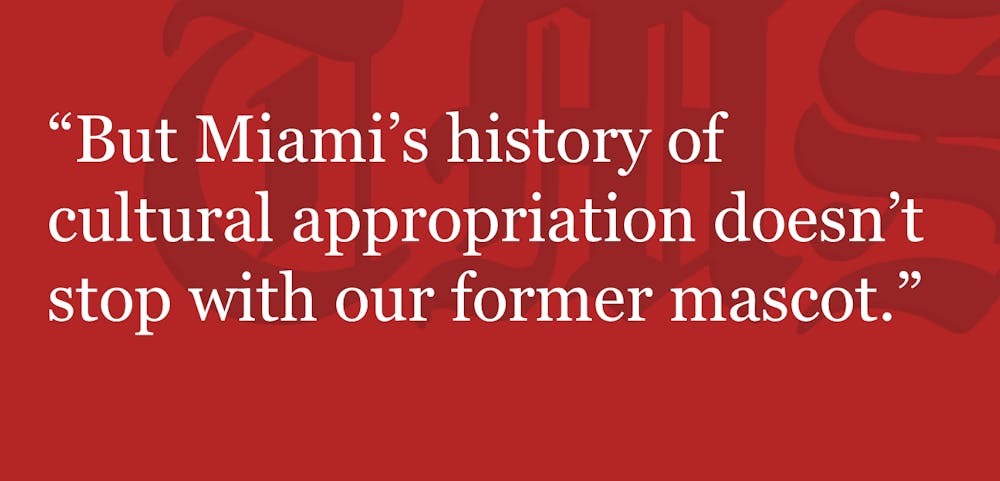Every year around Halloween, a similar conversation takes place across all social media platforms: what costumes are and aren’t considered “cultural appropriation?”
Put simply, cultural appropriation is when a person adopts an element of a different culture that they aren’t a part of. The cases of this phenomenon that most people are familiar with are those in which a member of a dominant culture – generally a white person – appropriates an aspect of a marginalized culture.
Nowadays, the more blatant forms of cultural appropriation — namely, costumes that explicitly mock people of other races and ethnicities — are generally viewed as inappropriate. But that wasn’t the case until relatively recently, as a quick look into Miami’s history demonstrates.
One of the most notable examples of Miami’s history of cultural insensitivity is its former mascot, the Redskins.
For years, Miami’s athletic teams were informally referred to as the “Big Reds.” In 1928, though, a sports writer for The Miami Student referred to the football team as the “Big Red-Skinned Warriors,” and by the early 1930s, the “Redskins” moniker became official.
Despite “redskins” being used as a derogatory term against Native Americans since early colonization, the use of the mascot was generally accepted for decades. In 1972, the Miami Tribe of Oklahoma even expressed support for the university’s use of the mascot.
In 1996, though, the Tribe rescinded its support, which was a driving force in Miami’s decision to change the mascot. In April 1997, the Board of Trustees voted to change the mascot to the RedHawks, and the change was finalized in July of that year.
Though this decision was in the best interests of both the university and the Miami Tribe, it was met with outrage from students and alumni alike.
Chad Hinton, editor-in-chief of the 1997 issue of Recensio, Miami’s now-defunct yearbook production, wrote then that he felt the Tribe asked Miami to change the name of the mascot because of societal pressures rather than an actual dislike for the name.
“If Miami wants to change its name because of what society thinks, then next time we should consider ‘J. Crew U,’” Hinton wrote. “I am and always will be a Redskin.”
Anger over the name change even caused some alumni to refuse to make donations to Miami. One particularly disgruntled alumnus returned a donation request form to the university with a note expressing frustration about “political correctness” scrawled on it.
“No ‘Redskins,’ no money,” the note reads. “‘Political correctness’ is making me sick – sorry to take it out on you.”
Enjoy what you're reading?
Signup for our newsletter
But Miami’s history of cultural appropriation doesn’t stop with our former mascot.
Western College for Women, which is now part of Miami, served as a training location for participants in the Freedom Summer campaign of 1964, during which northern students traveled to the south and attempted to register Black people to vote.
Miami now claims this history as its own and takes a great deal of pride in it. But, the university has a long history of racism that often overshadows this achievement.
In 2019, The Student found more than 20 racist images in issues of Recensio dating from 1960 to 1986. A few of these images feature students wearing blackface, others wearing Ku Klux Klan hoods and others wearing Middle Eastern dress.
In the mid-1990s, Miami students began an annual tradition in which they drank alcohol, played loud rap music and took pictures using stereotypically Black poses. The tradition, dubbed “Ghetto Fest,” lasted all the way until 2010, when controversy over the party’s racist connotations caused the organizers to shut it down.
The use of the Redskins mascot, the images found in Recensio and Ghetto Fest are the most blatant examples of cultural appropriation at Miami.
Though all three may seem like ancient history to current students, Redskins apparel is still available for purchase on many online sites, costumes that resemble those seen in Recensio are still plentiful at today’s Halloween parties, and Ghetto Fest ended just 10 years ago.
Rodney Coates, professor of global and intercultural studies, said that though these types of displays no longer exist at Miami, it’s often difficult to distinguish between cultural appropriation and appreciation when it comes to white people consuming Black culture.
“You go to parties sometimes, and they’re playing hip hop music, and individuals are trying to dance in various styles that are associated with Black culture,” Coates said. “Is that cultural appropriation? It’s hard to draw that line.”
Coates also argued that Green Beer Day, an annual tradition in which students drink beer dyed with green food coloring, is the largest current example of cultural appropriation at Miami as it plays into stereotypes about Irish-Americans.
“It’s an annual tradition at Miami University where we are ridiculing the Irish and the notion that the Irish are drunks, and I find it interesting that no one challenges that,” Coates said. “I guess it’s OK to appropriate a white minority ethnic group but not a black minority ethnic group.”




